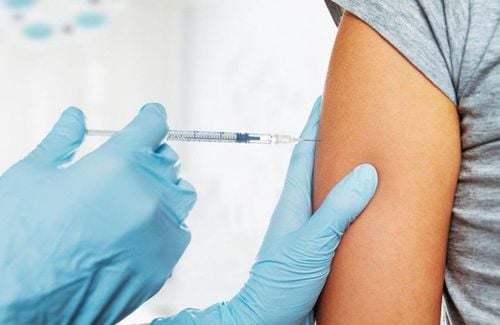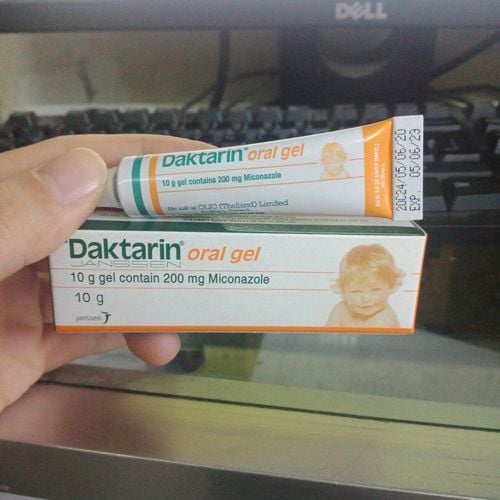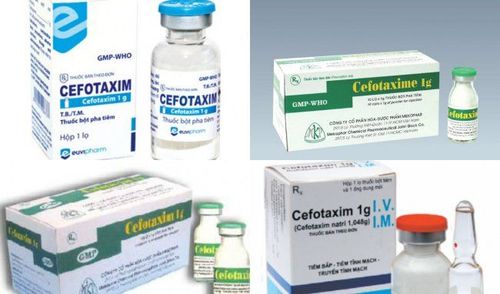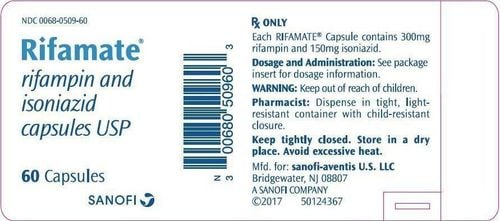This is an automatically translated article.
Indclav medicine is prepared in the form of powder for oral suspension, with the main ingredients being Amoxicillin and Potassium clavulanate. It is used in the short-term treatment of infections caused by strains of bacteria susceptible to Amoxicillin.
1. What is the effect of Indclav?
Each 5ml of reconstituted Indclav suspension contains: Amoxicillin trihydrate equivalent to 200mg Amoxicillin + Potassium clavulanate equivalent to clavulanic acid 28.5mg.
Amoxicillin is a semi-synthetic antibiotic of the beta - lactamin family, with a broad spectrum of antibacterial activity against many gram-negative and gram-positive bacteria due to its ability to inhibit bacterial cell wall synthesis. However, because Amoxicillin is easily destroyed by beta-lactamases, it is not active against strains of bacteria that produce these enzymes (many strains of Enterobacteriaceae and Haemophilus influenzae). And clavulanic acid is formed by the fermentation of Streptomyces clavuligerus, which has a beta-lactam structure similar to penicillin, capable of inhibiting beta-lactamase produced by most gram-negative bacteria and staphylococcus. In particular, it also has a strong inhibitory effect on plasmid-transmitted beta-lactamases that cause resistance to cephalosporins and penicillins. Clavulanic acid helps prevent Amoxicillin from being destroyed by beta-lactamases, and effectively extends the antibacterial spectrum of Amoxicillin to strains of bacteria already resistant to Amoxicillin, penicillins and other cephalosporins.
Indications for use of Indclav: Short-term treatment of infections caused by amoxicillin-sensitive beta-lactamase-producing strains of bacteria such as:
Upper respiratory tract infections (ear - nose - throat): Ear infections middle , recurrent tonsillitis, sinusitis; Lower respiratory tract infections: Bronchopneumonia, exacerbation of chronic bronchitis; Intra-abdominal, genitourinary tract infections: Cystitis (especially when recurrent, with complications, except prostatitis), postpartum and pelvic infections, post-abortion infections, internal infections Abdominal; Skin and soft tissue infections: Animal bite wound infections, cellulitis, severe tooth abscess combined with diffuse cellulitis; Mixed infections: Caused by bacteria sensitive to Amoxicillin combined with beta-lactamase producing bacteria sensitive to Amoxicillin + clavulanic acid mixture. Contraindications to the use of Indclav:
Patients who are sensitive to Penicillin; Pay attention to the possibility of cross-allergies with other beta-lactam antibiotics such as cephalosporins; Patients with a history of jaundice, liver dysfunction when taking Amoxicillin, clavulanic acid or penicillin.
2. Usage and dosage of Indclav
How to use: The patient shakes the bottle of Indclav to loosen the powder. Then, slowly add cooled boiled water to the mark marked on the bottle, shake well. Next, add water to the mark if necessary.
Patients should take Indclav right before meals to limit drug intolerance in the gastrointestinal tract. Absorption of the drug is optimal if administered at this time. The duration of drug treatment is prescribed by the doctor on a case-by-case basis, and should not be used for more than 14 days without assessing the effectiveness of treatment.
Dosage: Expressed as Amoxicillin in a compound:
Adults and children over 12 years old: Should not be used in powder form for oral suspension, should be used in tablet form; Children under 12 years old: Use 25mg/kg/day, divided into 8 hours apart. Specifically: Children under 1 year old: Use a dose of 25mg/kg/day. For example, for children weighing 7.5kg, use 3ml of suspension, 3 times a day; Children 2 - 6 years old (10 - 18kg): Use 5ml, 3 times a day; Children over 6 years old (18-40kg): Use 10ml dose, 3 times a day; If the child has a severe infection, the dose can be increased to 50mg/kg/day, divided into several doses, every 8 hours; Patients with renal impairment: Use the same starting dose as normal patients. Then, depending on the degree of renal failure, the following doses should be used: Clcr above 30ml/min: No dose adjustment needed, use the usual dose and dose interval exactly as recommended; Clcr 10 - 30ml/min: Dose equal to 1⁄2 starting dose every 12 hours; Clcr less than 10ml/min: Dose equal to 1/2 of the starting dose, every 24 hours; Patients with hepatic impairment: Indclav should be used with caution, monitoring liver function regularly. Overdose: In case the patient uses an overdose of Indclav, symptoms in the gastrointestinal tract and disturbances in water-electrolyte balance may occur. Symptomatic treatment of overdose should be done by balancing water and electrolytes. In addition, hemodialysis can be performed to remove drugs from the body's circulatory system. In some cases, the patient may have kidney failure.
3. Indclav side effects
Side effects of Indclav are uncommon, mostly mild and transient. Some side effects patients may experience when taking Indclav include: Digestive system: Diarrhea, nausea, vomiting, dyspepsia, Candida fungus on the skin mucosa, antibiotic-associated colitis (inflammation of the colon) hemorrhagic colitis and pseudomembranous colitis), tooth surface discoloration (usually removed by brushing); Urinary and genitourinary: Presence of drug crystals in the urine, pain, vaginal itching, discharge; Liver: Moderately elevated ALT, AST and alkaline phosphatase levels, hepatitis, cholestatic jaundice; Hypersensitivity reactions: Urticaria, erythema multiforme, erythema multiforme, toxic epidermal necrolysis, exfoliative dermatitis, Stevens-Johnson syndrome, serum sickness-like syndrome, acute generalized pustular rash , hypersensitivity vasculitis, angioedema, anaphylactic reactions, interstitial nephritis; Hematologic: Transient leukopenia (neutropenia and agranulocytosis), thrombocytopenia, hemolytic anemia, prolongation of bleeding time and prothrombin time; Central nervous system: Reversible hyperactivity, headache, dizziness, convulsions (in patients with renal failure or taking high doses of drugs). Patients should inform their doctor about the side effects they experience while taking Indclav to receive appropriate advice.
4. Be careful when using Indclav
Some notes for patients to remember before and while taking Indclav:
Be careful when using Indclav in patients with liver dysfunction because some patients taking Amoxicillin and clavulanic acid have changes in some liver function tests; Indclav can cause cholestatic jaundice but is usually reversible. The disease symptoms will disappear after stopping treatment for a few weeks; In patients with renal impairment, the dose of Indclav should be adjusted according to the degree of renal impairment and the state of decreased urine volume. When taking high doses of Amoxicillin, patients should drink enough fluids and maintain urine volume to reduce the risk of Amoxicillin crystallization in the urine. Serious, potentially fatal, hypersensitivity reactions have occurred in some patients receiving penicillin, especially those with a history of penicillin hypersensitivity; Patients taking Amoxicillin may have a rash with fever and lymphadenopathy; Prolonged use of Indclav may lead to overgrowth of non-susceptible strains of bacteria; Indclav should be avoided in pregnant women, especially during the first 3 months of pregnancy (unless authorized by your doctor); Indclav can be used in nursing women, should be used strictly according to the doctor's prescription; Indclav may cause dizziness, headache and convulsions, affecting the ability to drive and use machines. Patients should be wary of this condition.
5. Indclav drug interactions
Some drug interactions of Indclav include:
Patients treated with Amoxicillin and clavulanic acid may experience prolongation of bleeding time and prothrombin time. Therefore, Indclav should be used with caution in patients taking anticoagulants; Treatment with Amoxicillin and clavulanic acid can reduce the effectiveness of oral contraceptives, so patients should be aware of this; Concomitant use of Amoxicillin and allopurinol may increase the likelihood of an allergic skin reaction (skin rash); Probenecid reduces renal tubular secretion of Amoxicillin. Therefore, concurrent use of Probenecid with Amoxicillin and clavulanic acid may increase blood levels of Amoxicillin; Amoxicillin can lead to a false-positive reaction when a urine glucose test is performed. When using Indclav, patients should strictly follow the doctor's instructions to ensure the best infection treatment effect and avoid dangerous incidents.
Follow Vinmec International General Hospital website to get more health, nutrition and beauty information to protect the health of yourself and your loved ones in your family.
Please dial HOTLINE for more information or register for an appointment HERE. Download MyVinmec app to make appointments faster and to manage your bookings easily.













